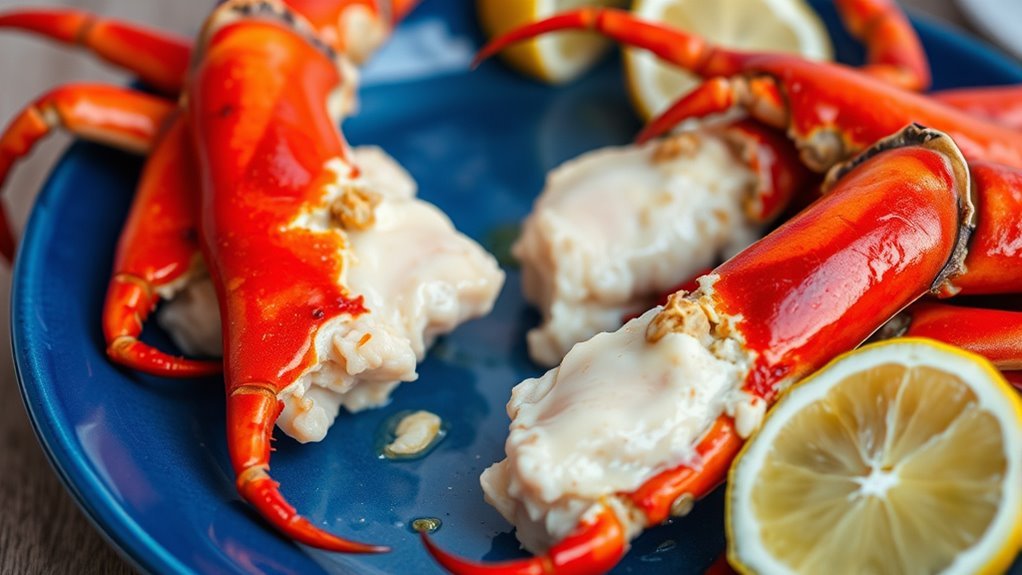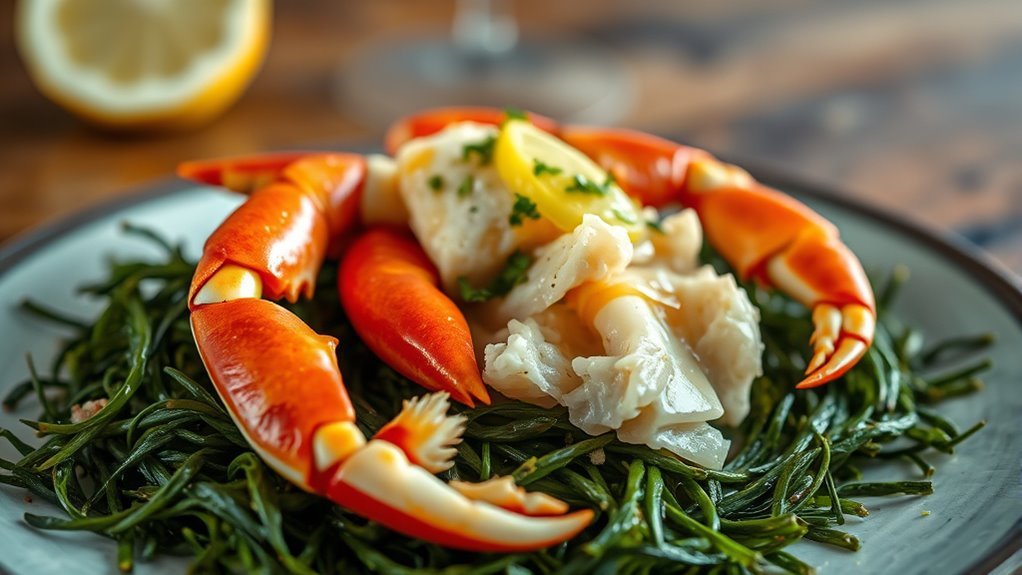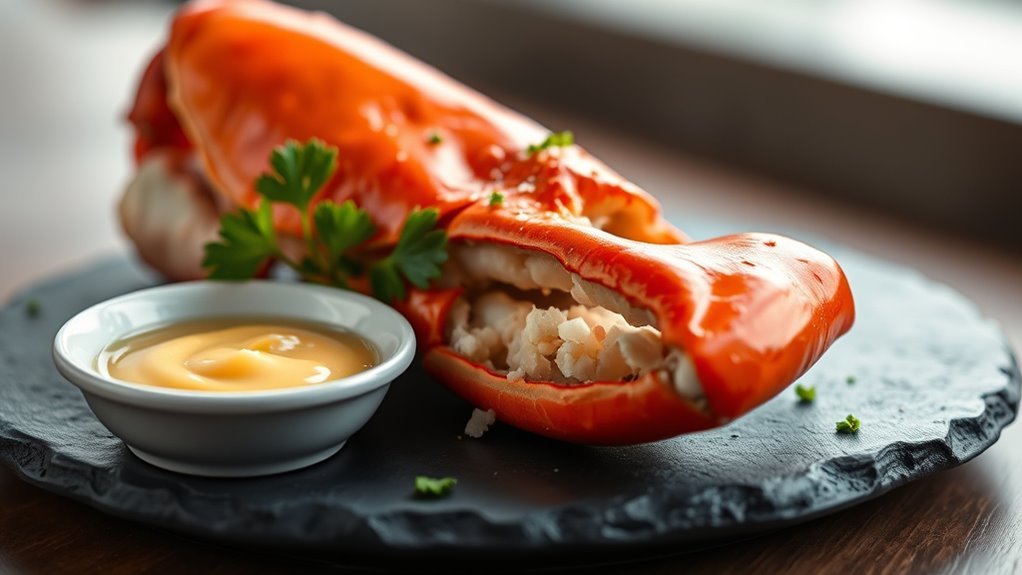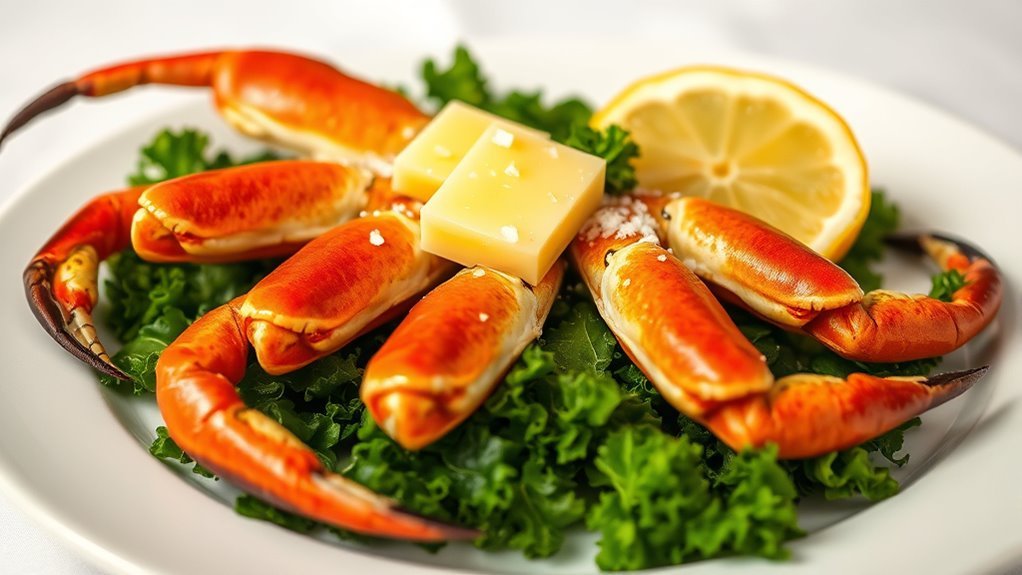Yes, crab is keto-friendly! It’s low in carbs, usually containing just 0-1 gram of carbs per 3-ounce serving. This makes it an excellent protein source for your keto diet, while also offering essential nutrients like omega-3 fatty acids and vitamin B12. Opting for fresh or frozen crab guarantees you maintain that low carb profile. If you’re curious about more benefits and how to incorporate crab into your meals, there’s plenty more to discover!
Nutritional Profile of Crab

Crab is often celebrated for its rich flavor and impressive nutritional profile. When you explore various crab varieties, you’ll find that they all offer significant health benefits. For example, blue crab is high in protein and low in fat, while king crab delivers an abundance of essential vitamins and minerals. The nutritional content can vary depending on the cooking methods used. Steaming or boiling tends to preserve more nutrients compared to frying or heavy seasoning. Not only does crab provide high-quality protein, but it’s also a source of omega-3 fatty acids, which are crucial for heart health. So, whether you’re grilling, baking, or simply enjoying crab legs, you’re making a nutritious choice that aligns with a balanced eating plan.
Carbohydrate Content in Crab

When considering crab in a keto diet, it’s essential to look at its carbohydrate content. Generally, crab is low in carbs, making it a suitable option for those monitoring their net carb intake. Comparing it to other seafood can help you understand how it fits into your overall dietary choices.
Nutritional Profile Overview
While many seafood options can be high in carbohydrates, crab stands out as a particularly keto-friendly choice. Different crab varieties, such as blue, king, and Dungeness, generally contain minimal carbs, making them suitable for a low-carb diet. When cooked using methods like steaming or grilling, you preserve the nutritional integrity while keeping carbohydrates low.
Crab meat is rich in protein and provides essential vitamins and minerals, such as vitamin B12 and selenium, contributing to overall health. By exploring various crab dishes, you can enjoy a delicious meal without worrying about excessive carbohydrate intake. Whether you prefer it in a salad or a hearty stew, crab offers versatility while fitting seamlessly into your keto lifestyle.
Net Carbs Calculation
Although many seafood options can vary in carbohydrate content, crab generally remains a low-carb choice, making it ideal for those following a ketogenic diet. When calculating net carbs, it’s essential to reflect on different crab varieties. Most types, like blue crab and snow crab, contain around 0-1 gram of net carbs per 3-ounce serving. This low carb count allows you to enjoy crab dishes without exceeding your daily carb limit. While some processed crab products may contain added sugars or fillers, fresh or frozen crab typically retains that minimal carb profile. So, whether you’re indulging in crab cakes or a simple crab salad, you can confidently include this seafood in your keto meal plan without worrying about significant carb intake.
Comparison With Other Seafood
Crab stands out among seafood options for its exceptionally low carbohydrate content, making it a favorable choice for those on a ketogenic diet. When you look at a seafood comparison, crab varieties like blue crab and king crab contain minimal carbs, allowing you to indulge without guilt.
Here’s a quick look at the carbohydrate content of popular seafood:
| Seafood | Carbohydrates (g) | Keto-Friendly |
|---|---|---|
| Blue Crab | 0.2 | Yes |
| King Crab | 0.2 | Yes |
| Shrimp | 0.9 | Yes |
| Salmon | 0 | Yes |
| Tilapia | 0 | Yes |
With these options, you can embrace your keto lifestyle while enjoying delicious seafood!
Health Benefits of Eating Crab

Eating crab can offer you a high-quality source of protein, which is essential for muscle repair and overall health. Additionally, crab is rich in important nutrients like vitamin B12, zinc, and omega-3 fatty acids, contributing to heart health and immune function. Incorporating crab into your diet can be a delicious way to support your nutritional needs.
High Protein Content
Seafood lovers often appreciate crab not just for its delicious taste but also for its impressive nutritional profile, particularly its high protein content. Crab is an excellent protein source, which can help you meet your dietary needs while enjoying a flavorful meal. This lean protein supports muscle growth, repair, and overall health.
Here’s a quick comparison of crab’s protein content:
| Food Item | Protein (g per 100g) |
|---|---|
| Crab | 19.0 |
| Chicken Breast | 31.0 |
| Salmon | 25.0 |
Rich in Nutrients
Not only is crab a fantastic source of protein, but it also offers a range of nutrients that contribute to overall health. Crab is highly regarded for its nutrient density, providing essential vitamins and minerals without excessive calories. You’ll find significant amounts of vitamin B12, which supports nerve function and red blood cell formation, and selenium, an antioxidant that helps protect your cells. Additionally, crab contains omega-3 fatty acids, promoting heart health and reducing inflammation. Its low-fat content makes it a great choice for those looking to maintain a healthy weight while enjoying delicious meals. With its impressive vitamin content and health benefits, adding crab to your diet can enhance your nutritional intake and support your wellness journey.
Protein in Crab and Its Importance
Although many people may overlook it, crab is a powerhouse of protein that can greatly contribute to a balanced diet. As a lean protein source, it provides essential amino acids necessary for muscle repair and growth. Incorporating crab into your meals can help you meet your daily protein requirements without excessive calories or unhealthy fats. Additionally, the dietary benefits of crab extend beyond protein; it’s rich in vitamins and minerals like vitamin B12 and zinc, which support overall health. By choosing crab as a protein source, you’re not just adding variety to your diet but also enhancing its nutritional value. So, whether you’re a seafood lover or just seeking healthier options, crab deserves a spot on your plate.
How Crab Fits Into the Keto Diet
Crab fits seamlessly into the keto diet, making it an excellent choice for those looking to maintain a low-carb lifestyle. With various crab varieties available, you can easily incorporate them into your meals without the guilt of excess carbs. Whether you’re grilling, steaming, or baking, crab cooking allows for flavorful, satisfying dishes that align with your keto goals.
| Crab Varieties | Carbs per 3 oz |
|---|---|
| King Crab | 0.0g |
| Snow Crab | 0.2g |
| Dungeness Crab | 0.0g |
| Blue Crab | 0.2g |
| Alaskan Crab | 0.0g |
Enjoy the freedom of delicious, low-carb meals by adding crab to your diet!
Different Types of Crab and Their Nutritional Values
When exploring the various types of crab, you’ll find that each variety offers unique flavors and nutritional profiles. Dungeness crab, known for its sweet, tender meat, is a great source of protein and essential nutrients. King crab, larger in size, provides a rich flavor and is high in vitamin B12. Snow crab, with its flaky texture, is another excellent option, offering lower calories and fat. Blue crab, popular in many cuisines, contains omega-3 fatty acids and is also nutrient-dense. Finally, soft shell crab, which is actually a molting blue crab, provides a unique eating experience with a delicate taste. Overall, crab meat from any type can be a nutritious addition to your diet while keeping it keto-friendly.
Delicious Keto-Friendly Crab Recipes
If you’re looking to incorporate crab into your keto diet, you’re in luck—there are plenty of delicious recipes that not only highlight crab’s rich flavors but also adhere to low-carb principles. One popular option is keto crab cakes, made with almond flour instead of breadcrumbs, ensuring they remain low in carbs while still being crispy and satisfying. Pair them with a tangy dipping sauce for an extra kick. Another fantastic dish is a revitalizing crab salad, combining fresh crab meat with avocado, cucumber, and a zesty lime dressing. This dish is not only light and flavorful but also packed with healthy fats, making it a perfect addition to your keto meal plan. Enjoy these dishes and savor the freedom of tasty, low-carb eating!
Tips for Selecting Fresh Crab
Choosing fresh crab can be a bit intimidating, especially with so many options available, but knowing what to look for can make the process easier. When selecting crab, check for crab freshness by looking at its shell; it should be hard and free from cracks. Fresh crab also has a clean, briny smell, reminiscent of the ocean, rather than a strong fishy odor. If you’re buying whole crabs, verify they’re lively and responsive. For crab meat, opt for bright white or pink flesh without dark spots. If you’re unsure, don’t hesitate to ask the vendor about the sourcing methods. By keeping these tips in mind, you can confidently choose high-quality crab for your meals. Enjoy your culinary adventure!
Potential Allergies and Considerations
When considering crab as part of your keto diet, it’s important to be aware of potential shellfish allergies that can affect some individuals. If you have a history of allergies, you should consult with a healthcare professional before including crab in your meals. Additionally, understanding the nutritional profile of crab can help you make informed decisions about how it fits into your overall dietary needs.
Common Shellfish Allergies
Shellfish allergies are among the most common food allergies, affecting millions of people worldwide. If you’re considering adding crab to your keto diet, it’s essential to understand the potential for allergic reactions. Shellfish allergies can trigger symptoms ranging from mild hives to severe anaphylaxis. Here’s a quick overview of common shellfish allergies:
| Shellfish Type | Common Allergens | Symptoms |
|---|---|---|
| Shrimp | Tropomyosin | Hives, swelling |
| Crab | Parvalbumin | Nausea, vomiting |
| Lobster | Parvalbumin | Abdominal pain |
| Shellfish Mix | Various proteins | Difficulty breathing |
Always consult with a healthcare professional if you suspect you have shellfish allergies. Being informed helps you enjoy your meals safely while exploring keto options.
Nutritional Considerations
If you’re considering crab as part of your keto diet, it’s important to weigh its nutritional benefits against potential allergies and dietary concerns. Crab is low in carbohydrates, making it a suitable option for keto enthusiasts, but allergies can be a significant barrier. If you’ve had seafood allergies in the past, it’s wise to consult a healthcare professional before indulging. Additionally, consider crab sustainability; overfishing can harm marine ecosystems, so look for responsibly sourced crab or crab farming options. Sustainable farming practices can help guarantee the future availability of crab while supporting environmental health. Balancing your dietary choices with sustainability and personal health can lead to a fulfilling keto experience.
Conclusion: Enjoying Crab on Keto
While many might worry about whether crab fits into a keto diet, the truth is that this delicious seafood can be a fantastic choice. With its low carb content and high protein, crab offers a versatile option for your meals. You can enjoy various crab varieties, like snow, king, or Dungeness, all while keeping your macros in check. Plus, when using keto substitutions, you can whip up delightful dishes without compromising your diet.
Here’s a quick comparison:
| Crab Variety | Carbs (per 3 oz) |
|---|---|
| King Crab | 0.5g |
| Snow Crab | 0.6g |
| Dungeness Crab | 0.4g |
| Blue Crab | 0.5g |
| Soft-Shell Crab | 0.3g |
Enjoy crab and savor your keto journey!
Frequently Asked Questions
Can I Eat Crab if I Have a Shellfish Allergy?
You shouldn’t eat crab if you have a shellfish allergy. It’s ironic, isn’t it? You might crave that sweet, succulent taste, but the symptoms—like hives or swelling—could ruin your feast. Instead, why not try alternatives like grilled chicken or plant-based seafood options? They can give you that satisfying flavor without the risk. Remember, your health is more important than any meal, so steer clear of crabs and embrace safer choices!
How Should Crab Be Stored to Maintain Freshness?
To maintain crab freshness, store it in the refrigerator at 32°F (0°C) and consume it within a couple of days. For longer storage, freezing methods are ideal. Wrap crab tightly in plastic wrap or aluminum foil, then place it in an airtight container or freezer bag to prevent freezer burn. Don’t forget to label it with the date! Proper refrigeration tips and freezing methods will help you enjoy your crab for longer.
Is Canned Crab Meat as Nutritious as Fresh Crab?
Canned crab meat can be just as nutritious as fresh crab, though there’re some differences. Canned crab benefits include convenience and a longer shelf life, making it a great option for quick meals. However, fresh crab often boasts a better flavor and texture, plus it can have higher protein levels. Both options provide essential nutrients, so it really depends on your preferences and how you plan to use them in your meals.
How Often Can I Eat Crab on a Keto Diet?
You can enjoy crab several times a week on a keto diet, as it’s low in carbs and high in protein. Incorporating crab into your keto meal planning can add variety without compromising your carb limits. Aiming for 2-3 servings per week is reasonable, but listen to your body and adjust as needed. Remember to balance your meals with other low-carb options to maintain ideal nutrition while enjoying the freedom of your diet.
Does Cooking Method Affect Crab’s Nutritional Content?
Yes, cooking method does affect crab’s nutritional content. Boiling can lead to some nutrient loss, particularly if you overcook it, but it preserves more moisture. On the other hand, grilling offers benefits like enhanced flavor and potentially less fat, as excess oils can drip away. Both methods keep crab low in carbs, so you can enjoy it on your diet. Just be mindful of how you cook it to retain those nutrients!


